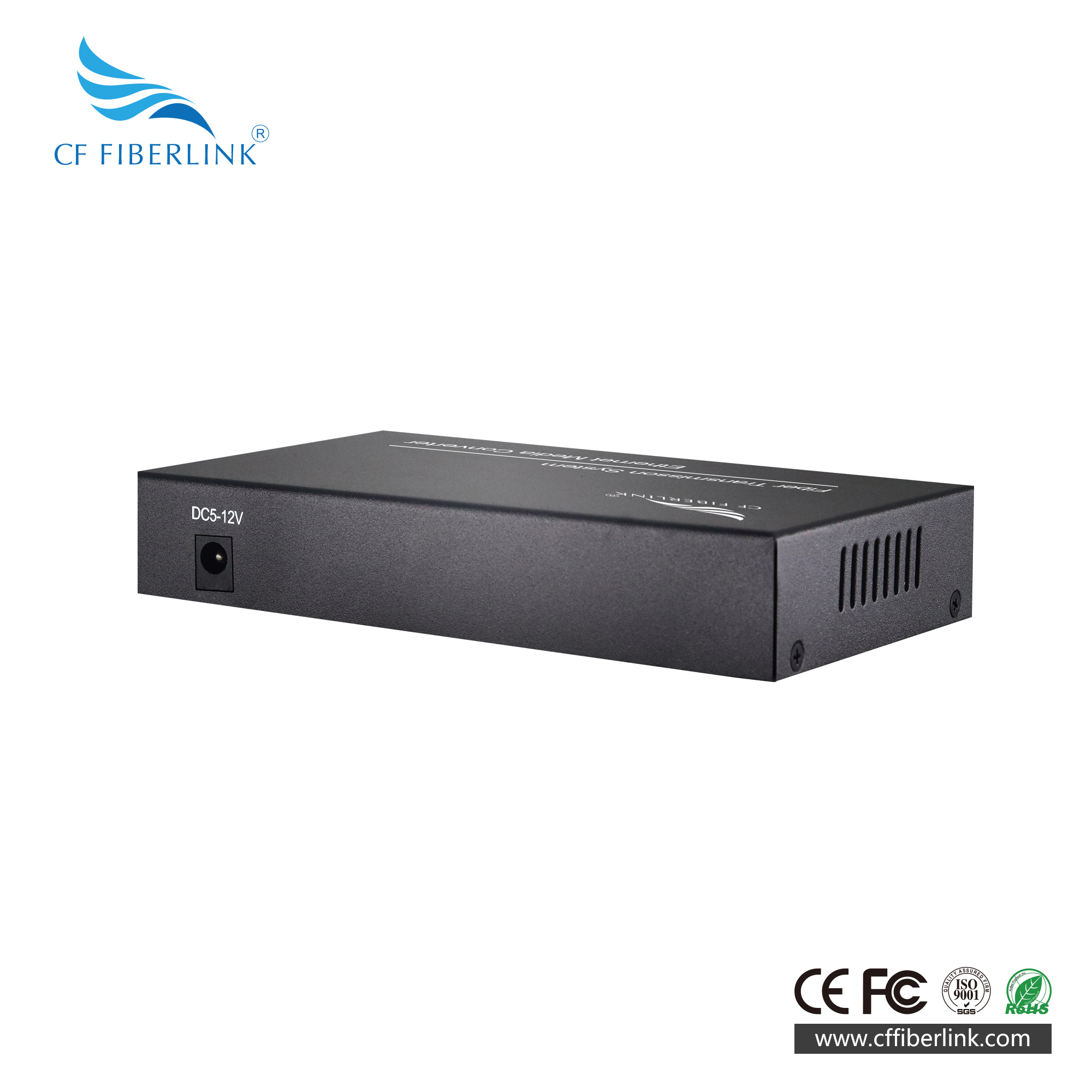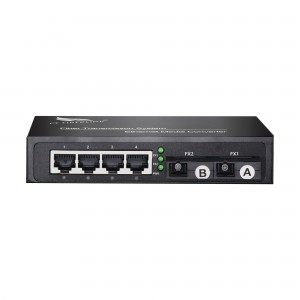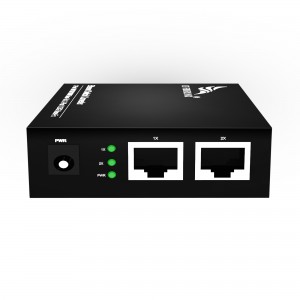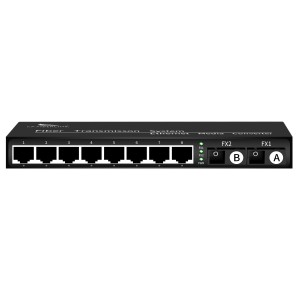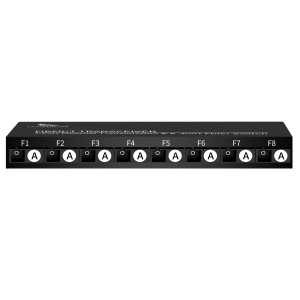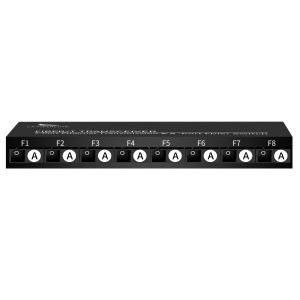6-port 10/100/1000M Media Converter (multi-mode Dual-fiber SC)
6-port 10/100/1000M Media Converter (multi-mode Dual-fiber SC)
Product Features:
Huizhou Changfei Optoelectronics Technology Co., Ltd. launched a gigabit 20km 2-optical 4-electrical multi-mode dual-fiber transceiver. This innovative product combines advanced technology with superior performance to provide a reliable and efficient communication solution.
This multimode fiber optic transceiver adopts SC fiber optic transceiver technology and is designed for outdoor environment. The transmission distance can reach 20 kilometers, ensuring long-distance communication with minimal signal loss. Equipped with two fiber channels and four electrical channels, it provides versatility and flexibility for data transmission.
Huizhou Changfei Photoelectric Technology Co., Ltd. is a well-known manufacturer of industrial communication products in China. Focusing on providing high quality and reliable network solutions, they have become a trusted name in the market. Its extensive product range includes cloud-managed industrial switches, PoE switches, Ethernet switches, fiber optic transceivers and wireless transmission equipment.
Gigabit 20 km 2 Optical 4 Electrical Multimode Dual Fiber Transceiver designed to withstand harsh environments. Its iron shell design provides durability and ensures peak performance in harsh conditions. In addition, it has an IP30 dust and water resistance rating. With these features, it is suitable for a variety of outdoor applications, including security systems, industrial automation, and transportation networks.
Another notable feature of this transceiver is its ability to be powered from an external power source. This provides installation flexibility and allows seamless integration into existing systems. Additionally, it supports hot-swapping for easy maintenance and upgrades without disrupting network operations.
Gigabit 20km2 optical 4 electrical multimode dual fiber optic transceiver provides high speed data transmission and excellent reliability. Support for Gigabit Ethernet ensures fast and efficient communication. With its multimode fiber technology, it provides excellent signal quality and stability over long distances.
At Huizhou Changfei Photoelectric Technology Co., Ltd., customer satisfaction is the top priority. They are committed to providing comprehensive solutions and services to meet the diverse needs of users. By expanding their expertise in industrial communication fields such as Industrial Ethernet, Industrial Wireless, Fieldbus, Edge Computing and Network Integration, they aim to become a world-class expert in industrial communication.
To sum up, the gigabit 20km 2 optical 4 electrical multimode dual-fiber transceiver is a reliable and efficient communication solution. With its advanced features, rugged design, and support from a trusted manufacturer, it’s perfect for outdoor applications. Experience seamless connectivity and improved performance with this high-quality transceiver from Huizhou Changfei Optoelectronics Technology Co., Ltd.
Technical Parameter:
|
Model |
CF-2024GMW-2 | |
| Interface Characteristics | ||
|
Fixed Port |
4* 10/ 100/ 1000Base-T RJ45 port 2* 1000Base-X uplink SC fiber port |
|
|
Ethernet Port |
10/ 100/ 1000Base-T auto-sensing, full/half duplex MDI/MDI-X self-adaption |
|
|
Twisted Pair Transmission |
10BASE-T: Cat3,4,5 UTP(≤100 meter) 100BASE-T: Cat5e or later UTP(≤100 meter) 1000BASE-T : Cat5e or later UTP(≤100 meter) |
|
| Optical Port | The default optical module is multimode dual fiber 2km, SC port | |
| Wavelength/Distance | multimode: 850nm 0~550M,1310nm 0~2KM | |
| Chip Parameter | ||
| Network Protocol | IEEE802.3 10BASE-T, IEEE802.3i 10Base-T,
IEEE802.3u 100Base-TX, IEEE802.3u 100Base-FX, IEEE802.3x IEEE802.3ab 1000Base-T;IEEE802.3z 1000Base-X; |
|
|
Forwarding Mode |
Store and Forward(Full Wire Speed) |
|
|
Switching Capacity |
12Gbps |
|
|
Buffer Memory |
8.92Mpps | |
|
MAC |
2K | |
|
LED Indicator |
Fiber | FX1(green)/FX2(green) |
| Data | 1-4 Green: Indicates network working status | |
| Power | PWR (green) | |
| Power | ||
| Working Voltage |
AC:100-240V |
|
|
Power Consumption |
Standby<1W, Full load<5W |
|
|
Power Supply |
DC:5V/2A industrial power supply |
|
| Lightning protection &Certification | ||
| Lightning protection | Lightning protection: 4KV 8/20us, Protection level: IP30 | |
| Certification | CCC;CE mark, commercial; CE/LVD EN60950;FCC Part 15 Class B; RoHS | |
| Physical Parameter | ||
| Operation TEMP | -20~+55°C;5%~90% RH Non condensing | |
| Storage TEMP |
-40~+85°C;5%~95% RH Non condensing |
|
| Dimension (L*W*H) | 142mm* 92mm*30mm | |
| Installation | Desktop | |
Product Size:
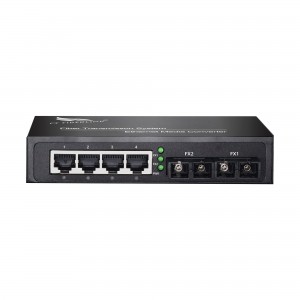
product application diagra:

How to choose a fiber optic transceiver?
Optical fiber transceivers break the 100-meter limitation of Ethernet cables in data transmission. Relying on high-performance switching chips and large-capacity caches, while truly achieving non-blocking transmission and switching performance, they also provide balanced traffic, isolation and conflict. Error detection and other functions ensure high security and stability during data transmission. Therefore, fiber optic transceiver products will still be an indispensable part of actual network construction for a long time. So, how should we choose fiber optic transceivers?
1. Port function test
Mainly test whether each port can work normally in the duplex state of 10Mbps, 100Mbps and half-duplex state. At the same time, it should be tested whether each port can automatically select the highest transmission speed and automatically match the transmission rate of other devices. This test can be included in other tests.
2. Compatibility test
It mainly tests the connection ability between the optical fiber transceiver and other devices compatible with Ethernet and Fast Ethernet (including network card, HUB, Switch, optical network card, and optical switch). The requirement must be able to support the connection of compatible products.
3. Cable connection characteristics
Test the fiber optic transceiver’s ability to support network cables. First, test the connection ability of Category 5 network cables with lengths of 100m and 10m, and test the connection ability of long Category 5 network cables (120m) of different brands. During the test, the optical port of the transceiver is required to have a connection capability of 10Mbps and a rate of 100Mbps, and the highest must be able to connect to a full-duplex 100Mbps without transmission errors. Category 3 twisted pair cables may not be tested. Subtests can be included in other tests.
4. Transmission characteristics (transmission loss rate of data packets of different lengths, transmission speed)
It mainly tests the packet loss rate when the optical fiber transceiver optical port transmits different data packets, and the connection speed under different connection rates. For the packet loss rate, you can use the test software provided by the network card to test the packet loss rate when the packet size is 64, 512, 1518, 128 (optional) and 1000 (optional) bytes under different connection rates. , the number of packet errors, the number of packets sent and received must be more than 2,000,000. Test transmission speed can use perform3, ping and other software.
5. The compatibility of the whole machine to the transmission network protocol
It mainly tests the compatibility of fiber optic transceivers to network protocols, which can be tested in Novell, Windows and other environments. The following low-level network protocols such as TCP/IP, IPX, NETBIOS, DHCP, etc. must be tested, and the protocols that need to be broadcast must be tested. Optical transceivers are required to support these protocols (VLAN, QOS, COS, etc.).
6. Indicator status test
Test whether the status of the indicator light is consistent with the description of the panel and the user manual, and whether it is consistent with the current status of the fiber optic transceiver.


2.jpg)
3.jpg)


